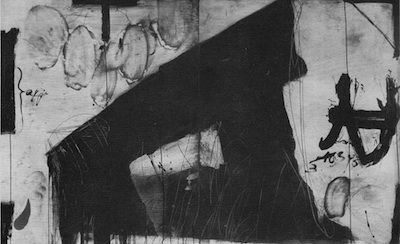Emptiness was both subject and source for the Abstract Expressionists. Within the boundaries defined by an empty white canvas, they found an arena for action and awareness, and they explored it with varying degrees of clarity. Some, such as Willem de Kooning and Jackson Pollock, painted from the deep unconscious, from that free place beyond rational calculation. Others, such as Robert Motherwell molded an ideal of freedom with the tool kit of an intellectual.
Their Catalan colleague, Antoni Tàpies, Spain’s foremost living abstract painter, is a member of that milieu, though his affiliation is with art informel, or Lyrical Abstraction, the European equivalent of Abstract Expressionism. Tàpies is also a Zen Buddhist who leads a simple life. “I do nothing but meditate and paint, meditate and paint,” he told writer Alan Riding in a recent interview in the New York Times. Although his reading has been legendarily broad, ranging through the world’s philosophy, theology, and literature, Tàpies “found a spiritual home in Zen Buddhism,” Riding writes. “And now, through his paintings, he struggles to achieve “‘the ultimate mysterious unity’ that links the entire universe.”
Indisputably, Buddhism touched one or another of the painters of the forties and fifties, but whom and how much remains to be determined. Ad Reinhardt read enough tantric teaching to create his own “mandalas”: satiric drawings of the small New York art universe, with its layered cosmologies, its bodhisatvas and demons. His black paintings (shades of black, at the edge of dissolution) were his response to the creative negation of “no-mind.”

Artists of that era universally shied away from an open affiliation with Buddhism, however. Mark Tobey, who traveled in Asia and lived in Japan, and who professed the Bahai faith, was cagey about his interest in Zen. His “white writing” paintings invoke a harmonious, meditative cosmos of equalized energies. Was his Zen perhaps also personal? Franz Kline, who might be thought to have the strongest affinity with Zen, vehemently decried the constant comparison between his black-and-white gesture paintings and calligraphy. He protested that he was an American painter, as though to resolve a troublesome issue. It is rare to hear a declaration as unambiguous as Tàpies’s acknowledgment of Zen.
Tàpies grew up in an intellectually sophisticated household in Barcelona. His well-to-do parents were versed in law and publishing and in Asian culture. At a young age, Tàpies discovered both the writings of a Sufi mystic and Kakuzo Okakura’s Book of Tea (given to him by his father). His essays, some of which are reproduced in the Guggenheim Museum catalogue for its recent Tàpies exhibition, wander afield through Taoism, the Christian Trinity and the early mystics, Surrealism and Dada, Heraclitus and Hegel, various sutras, the Vedanta, the Japanese philosopher Nyoiti Sakurazawa, the I Ching, and onward.
Tàpies’s involvement in Buddhism is veiled, but clearly there. He writes of a mystical oneness that the “Eastern religions” recognize, and notes the importance of ku, emptiness. He defends Buddhism and its family tree against what he clearly feels are skeptics and naysayers, but he also argues that no artist illustrates a philosophy in his/her art.
At the same time, however, Tàpies mentions the Zen sage Bodhidharma’s “contemplation of the wall” as speaking most strongly to his own vision of his painterly enterprise. Walls, in Tàpies’s aesthetic, are the material presence – the matter – that teases the meditating mind with its otherness. His paintings in the Guggenheim exhibition, chosen by curator Carmen Giménez, are from two series: the “matter” paintings, and the assemblages. In truth, the two are philosophically one.
Tàpies’s “matter” paintings – typically wall-size plywood slabs covered by a hardened crust of sand-like marble dust – offer a kind of Mediterraneanesque fresco. Into this surface, which resembles a beach below the tide line, Tàpies imprints his presence: laying down paint, inscribing lines, adding objects; in one case impressing a watercolor paintbox onto the wet surface to gain a colorful imprint. Sometimes he walks across the softened sand, leaving footprints. These works raise the question: What might Zen painting look like if it wasn’t done with an ink brush?
In assemblage, the artist gathers ordinary objects, each with its own lived history: a shattered plate, a metal washtub, an ironing board, a bundle of straw wrapped in canvas, a pair of pants (Tàpies weaves his corduroys to the picture frame with a net of wire).
Although assemblage has a long history in the twentieth century, its importance in Tàpies’s generation was secured by Robert Rauschenberg, a close friend of John Cage, who was a sometime student of D. T. Suzuki. Along this wandering Zen path one can glimpse the fascinating potential, for artists, of scrapping dualisms such as matter and mind. The reward is liberation from the obligation of interpretation, with its implicit self-centeredness. (“What does this painting mean to me?” is the question that Rauschenberg tossed out the window.)
Bodhidharma’s wall, for Tàpies, is a kind of koan. What is the wall, exactly, and why did Bodhidharma spend so many years contemplating it? What is the painter’s point of intersection with matter? What is will? Where does oneness manifest in the painter’s project?
From Surrealism, Tàpies inherited such useful devices as surprise, chance, and the unexpected conjunction. In Buddhism, he most likely encountered the meditator’s taste of freedom, the opening to the uncluttered heart and the unencumbered thought.
As with any of us, his depth of insight is registered in the clarity of his actions. Interestingly, Tàpies’s paintings of the fifties are more cluttered and less intuitively radical than are those of the eighties and nineties. One can see the complications dropping away, and can experience, along with the painter, the clear stream of flowing change.
Kay Larson was New York magazine’s art critic from 1980 to 1994. She is currently working on a book about twentieth-century art.
Thank you for subscribing to Tricycle! As a nonprofit, we depend on readers like you to keep Buddhist teachings and practices widely available.